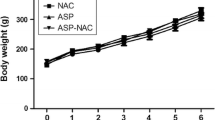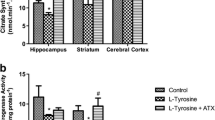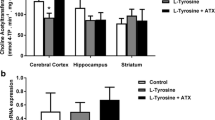Summary
1 We have previously demonstrated that arginine administration induces oxidative stress and compromises energy metabolism in rat hippocampus. In the present study we initially investigated the influence of pretreatment with α-tocopherol and ascorbic acid on the effects produced by arginine on hippocampus energy metabolism. We also tested the effect of acute administration of arginine on various parameters of energy metabolism, namely glucose uptake, lactate release and on the activities of succinate dehydrogenase, complex II and cytochrome c oxidase in rat cerebellum, as well as the influence of pretreatment with α-tocopherol and ascorbic acid on the effects elicited by arginine on this structure.
2. Sixty-day-old female Wistar rats were treated with a single i.p. injection of saline (control) or arginine (0.8 g/kg) and were killed 1 h later. In another set of experiments, the animals were pretreated for 1 week with daily i.p. administration of saline (control) or α-tocopherol (40 mg/kg) and ascorbic acid (100 mg/kg). Twelve hours after the last injection of the antioxidants the rats received one i.p. injection of arginine (0.8 g/kg) or saline and were killed 1 h later.
3. Results showed that arginine administration significantly increased lactate release and diminished glucose uptake and the activities of succinate dehydrogenase and complex II in rat cerebellum. In contrast, complex IV (cytochrome c oxidase) activity was not changed by this amino acid. Furthermore, pretreatment with α-tocopherol and ascorbic acid prevented the impairment of energy metabolism caused by hyperargininemia in cerebellum and hippocampus of rats.




Similar content being viewed by others
REFERENCES
Anderson, D. K. F., Waters, T. R., and Means, E. D. (1988). Pretreatment with α-tocopherol enhances neurologic recovery after experimental spinal cord compression injury. J. Neurotrauma 5:61–67.
Bavaresco, C. S., Calcagnotto, T., Tagliari, B., Delwing, D., Lamers, M. L., Wannmacher, C. M. D., Wajner, M., and Wyse, A. T. S. (2002). Brain Na+, K+-ATPase inhibition induced by arginine administration is prevented by vitamins E and C. Neurochem. Res. 28:825–829.
Bitterman, N., and Bitterman, H. (1998). L-Arginine-NO pathway and CNS oxygen toxicity. J. Appl. Physiol. 84:1633–1638.
Blouin, J. S., Bard, C., and Paillard, J. (2004). Contribution of the cerebellum to self-initiated synchronized movements: a PET study. Exp. Brain Res. 155:63–68.
Böger, R. H., Bode-Böger, S. M., Phivthong-ngam, L., Brandes, R. P., Schwedhelm, E., Mügge, A., Böhme, M., Tsikas, D., and Frölich, J. C. (1998). Dietary L-arginine and α-tocopherol reduce vascular oxidative stress and preserve endothelial function in hypercholesterolemic rabbits via different mechanisms. Atherosclerosis 141:31–43.
Bowling, A. C., and Beal, M. F. (1995). Bioenergetic and oxidative stress in neurodegenerative diseases. Life Sci. 56:1151–1171.
Brusilow, S. W., and Horwich, A. (2001). Urea cycle enzymes. In Scriver, C. R., Beaudet, A. L., Sly, W. S., and Valle, D. (eds.), The Metabolic and Molecular Bases of Inherited Disease, 8th Ed, McGraw-Hill, Inc., New York, pp. 1909–1963.
Buchmann, I., Milakofsky, L., Harris, N., Hofford, J. M., and Vogel, W. H. (1996). Effect of arginine administration on plasma and brain levels of arginine and various related amino compounds in the rat. Pharmacology 53:33–142.
Carreau, A., Duval, D., Poignet, H., Scatton, B., Vigé, X., and Nowicki, J. P. (1994). Neuroprotective efficacy of Nω-nitro-L-arginine after focal cerebral ischemia in the mouse and inhibition of cortical nitric oxide synthase. Eur. J. Pharmacol. 256:241–249.
Cederbaum, C. D., Shaw, K. N. F., Spector, E. B., Verity, M. A., Snodgrass, P. J., and Sugarmann, G. I. (1979). Hyperargininemia with arginase deficiency. Pediatr. Res. 13:827–833.
Dawson, V. L., and Dawson, T. M. (1996). Nitric oxide neurotoxicity. J. Chem. Neuroanat. 10:179–190.
Debaere, F., Wenderoth, N., Sunaert, S., Van Hecke, P., and Swinnen, S. P. (2004). Cerebellar and premotor function in bimanual coordination: parametric neural responses to spatiotemporal complexity and cycling frequency. Neuroimage 21:1416–1427.
Delwing, D., Delwing, D., Wannamacher, C. M. D., Wajner, M., Dutra-Filho, C. S., and Wyse, A. T. S. (2002). Arginine administration reduces catalase activity in midbrain of rats. Neuroreport 13:1301–1304.
Delwing, D., Tagliari, B., Streck, E. L., Wannmacher, C. M. D., Wajner, M., and Wyse, A. T. S. (2003). Reduction of energy metabolism in rat hippocampus by arginine administration. Brain Res. 983:58–63.
Demchenko, I. T., Boso, A. E., Bennett, P. B., Whorton, R. A., and Piantadosi, C. A. (2000). Hyperbaric oxygen reduces cerebral blood flow by inactivating nitric oxide. Nitric oxide Biol. Chem. 4:597–608.
Demchenko, I. T., Atochin, D. N., Boso, A. E., Astern, J., Huang, P. L., and Piantadosi, C. A. (2003). Oxygen seizure latency and peroxynitrite formation in mice lacking neuronal or endothelial nitric oxide synthases. Neurosci. Lett. 344:53–56.
D’Hooge, R., and De Deyn, P. P. (2001). Applications of the Morris water maze in the study of learning and memory. Brain Res. Brain Res. Rev. 36:60–90.
Ding-Zhou, L., Marchand-Verrecchia, C., Croci, N., Plotkine, M., and Margaill, I. (2002). L-NAME reduces infarction, neurological deficit and blood-brain barrier disruption following cerebral ischemia in mice. Eur. J. Pharmacol. 457:137–146.
Dutra, J. C., Wajner, M., Wannamacher, C. F., Dutra-Filho, C. S., and Wannamacher, C. M. D. (1991). Effects of methylmalonate and propionate on glucose and ketone bodies uptake in vitro by brain of developing rats. Biochem. Med. Metab. Biol. 45:56–64.
Feigl, E. O. (1988). EDRF: a protective factor? Nature 331:490–491.
Fighera, M. R., Queiroz, C. M., Stracke, M. P., Brauer, M. C., Gonzales-Rodriguez, L. L., Frussa-Filho, R., Wajner, M., and Mello, C. F. (1999). Ascorbic acid and α-tocopherol attenuate methylmalonic acid-induced convulsions. Neuroreport 10:2039–2043.
Fischer, J. C., Ruitenbeek, W., Berden, J. A., Trijbels, J. M., Veerkamp, J. H., Stadhouders, M. S., Sengers, R. C., and Janssen, A. J. (1985). Differential investigation of the capacity of succinate oxidation in human skeletal muscle. Clin. Chim. Acta 153:23–36.
Halliwell, B., and Gutteridge, J. M. C. (1985). Oxygen radicals and nervous system, Trends. Neurosci. 8:22–26.
Hamda, Y., Hayakawa, T., Hattori, H.,and Mikawa, H. (1994). Inhibitor of nitric oxide synthesis reduces hypoxic-ischemic brain damage in the neonatal rat. Pediatr. Res. 35:10–14.
Hara, H., Kato, H., and Kogure, K. (1990). Protective effect of α-tocopherol on ischemic neuronal damage in the gerbil hippocampus. Brain Res. 510:335–338.
Heales, S. J. R., Bolaños, J. P., Stewart, V. C., Brookes, P. S., Land, J. M., and Clark, J. B. (1999). Nitric oxide, mitochondria and neurological disease. Biochem. Biophys. Acta. 1410:215–228.
Hu, J. R., Ferreira, A., and Van Eldik, L. J. (1997). S100 beta induces neuronal cell death through nitric oxide release from astrocytes. J. Neurochem. 69:2294–2301.
Iyer, R., Jenkinson, C. P., Vockley, J. G., Kern, R. M., Grody, W. W., and Cederbaum, S. (1998). The human arginases and arginase deficiency. J. Inher. Metab. Dis. 21:86–100.
Kawano, H., Motoyama, T., Hirai, N., Kugiyama, K., Yasue, H., and Ogawa, H. (2002). Endothelial dysfunction in hypercholesterolemia is improved by L-arginine administration: possible role of oxidative stress. Atherosclerosis 161:375–380.
Lowry, O. H., Rosebrough, N. J., Farr, A. L., and Randall, R. J. (1951). Protein measurement with the Folin phenol reagent. J. Biol. Chem. 193:265–267.
Maragos, F. W., and Silverstein, F. S. (1995). Inhibition of nitric oxide synthase activity attenuates striatal malonate lesions in rats. J. Neurochem. 64:2362–2365.
Mügge, A., Brandes, R. P., Böger, R. H., Dwenger, A., Bode-Boger, S., Kienke, S., Frolich, J. C., and Lichtlen, P. R. (1994). Vascular release of superoxide radicals is enhanced in hypercholesterolemic rabbits. J. Cardiovasc. Pharmacol. 24:994–998.
Oury, T. D., Ho, Y. S., Piantadosi, C. A., and Crapo, J. D. (1992). Extracellular superoxide dismutase, NO and central nervous system O2 toxicity. Proc. Natl. Acad. Sci. USA 89:9715–9719.
Reis, E. A., Oliveira, L. S., Lamers, M. L., Netto, C. A., and Wyse, A. T. S. (2002). Arginine administration inhibits hippocampal Na+, K+-ATPase activity and impairs retention of an inhibitory avoidance task in rats. Brain Res. 951:151–157.
Rustin, P., Chretien, D., Bourgeron, T., Gérard, B., Rötig, A., Saudubray, J. M., and Munnich, A. (1994). Biochemical and molecular investigations in respiratory chain efficiencies. Clin. Chim. Acta 228:35–51.
Shimojo, N., Naka, K., Nakajima, C., Yoshikawa, C., Okuda, K., and Okada, K. (1989). Test-strip method for measuring lactate in whole blood. Clin. Chem. 35:1992–1994.
Squire, L. R. (2004). Memory systems of the brain: A brief history and current perspective. Neurobiology of Learning and Memory 82:171–177.
Terheggen, H. G., Schwenk, A., Lowenthal, A., Van Sandh, M., and Colombo, J. P. (1969). Argininaemia with arginase deficiency. Lancet 2:748.
Trifeletti, R. R. (1992). NG-nitro-L-arginine in focal stroke in the 7 day old rat. Eur. J. Pharmacol. 218:197–198.
Trinder, P. A. (1969). Determination of blood glucose using on oxidase-peroxidase system with a non-carcinogenic chromogen. J. Clin. Pathol. 22:158–161.
Van der Vliet, A., Smith, D., O'Neill, C. A., Kaur, H., Darley-Usmar, V., Cross, C. E., and Halliwell, B. (1994). Interactions of peroxynitrite with human plasma and its constituents: oxidative damage and antioxidant depletion. Biochem. J. 303:295–301.
Vasquez-Vivar, J., Santos, A. M., Junqueira, V. B. C., and Augusto, O. (1996). Peroxynitrite-mediated formation of free radicals in human plasma: EPR detection of ascorbyl, albumin-thiyl, and puric acid derived free radicals. Biochem. J. 314:869–876.
Vatassery, G. T. (1998). D. Geriatrics 53(Suppl 1):S25–S27.
Vatassery, G. T., DeMaster, E. G., Lai, J. C. K., Smith, W. E., and Quach, H. T. (2004). Iron uncouples oxidative phosphorylation in brain mitochondria isolated from vitamin E-deficient rats. Biochim. Biophys. Acta 1688:265–273.
Wyse, A. T. S., Bavaresco, C. S., Bandinelli, C., Streck, E. L., Franzon, R., Dutra-Filho, C. S., and Wajner, M. (2001). Nitric oxide synthase inhibition by L-NAME prevents the decrease of Na+, K+-ATPase activity in midbrain of rats subjected to arginine administration. Neurochem. Res. 26:515–520.
Wyse, A. T. S., Stefanello, F. M., Chiarani, F., Delwing, D., Wannmacher, C. M. D., and Wajner, M. (2004). Arginine administration decreases cerebral cortex acetylcholinesterase and serum butyrylcholinesterase probably by oxidative stress induction. Neurochem. Res. 29:385–389.
Zhang, J., Su, Y., Oury, T. D., and Piantadosi, C. A. (1993). Cerebral aminoacid norepinephrine and nitric oxide metabolism in CNS oxygen toxicity. Brain Res. 606:56–62.
ACKNOWLEDGEMENTS
This work was supported in part by grants from CNPq and PRONEX/ CNPq/FAPERGS, Brazil.
Author information
Authors and Affiliations
Corresponding author
Rights and permissions
About this article
Cite this article
Delwing, D., Tagliari, B., Chiarani, F. et al. α-Tocopherol and Ascorbic Acid Administration Prevents the Impairment of Brain Energy Metabolism of Hyperargininemic Rats. Cell Mol Neurobiol 26, 177–189 (2006). https://doi.org/10.1007/s10571-006-9022-3
Received:
Accepted:
Published:
Issue Date:
DOI: https://doi.org/10.1007/s10571-006-9022-3




